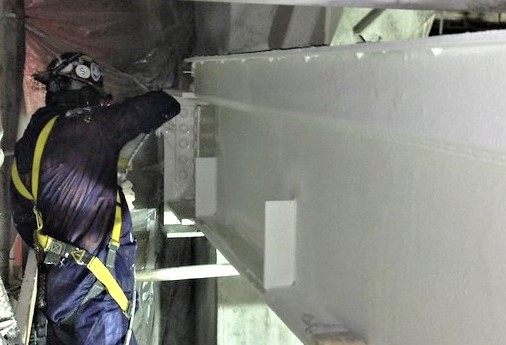Fire retardant

|
| Workers apply intumescent paint to a floor beam at the 44th Street facility. Source: MTA Construction & Development Mega Projects. |
Contents |
[edit] Introduction
A fire retardant is a substance such as a coating, powder, foam, gel or spray, that is used to slow - and eventually stop - the spread of fire. It is a preventive measure that can help limit a fire’s spread by triggering a chemical reaction.
[edit] History
The earliest form of fire retardants (which were thought to have originated many centuries ago) were substances such as vinegar, alum and clay that were used to treat timber and some fabrics.
More complex fire retardants were introduced in the 19th century in the form of flame retardants for fabrics. These were developed by Joseph Louis Gay-Lussac, a French chemist who made a number of discoveries in the idea of temperature and its relationship to gas pressure (Gay-Lussac’s Law or Amontons's law).
His exploration of the use of salts as fire retardants was groundbreaking, but it wasn’t until the 1900s that more effective measures would be introduced in the form of flame retardants.
[edit] Fire retardant or flame retardant?
Modern fire retardants and flame retardants have similar purposes - to control fires - but they achieve this by different methods:
- Flame retardants are chemicals (such as aluminium hydroxide) usually applied to combustible materials (such as textiles, plastics and coatings).
- Fire retardants are chemicals (for example, ammonium and diammonium sulfate) that can also be used on surfaces, but different types of chemicals are used for different purposes. Fire retardants as extinguishers include chemicals that will absorb a great deal of heat to cool whatever has been treated. Other agents will react with the heat to put out the fire by releasing water vapour or carbon dioxide. This is a physical process called dilution. Other fire retardants are intumescent coatings (such as paints or plastic additives). These rely on substances that will expand through a chemical reaction when heated to protect the materials that have been coated. For more information see: Intumescent coatings.
NB Fire retardants can also be dropped from planes to extinguish forest fires.
[edit] Related articles on Designing Buildings Wiki
Featured articles and news
RTPI leader to become new CIOB Chief Executive Officer
Dr Victoria Hills MRTPI, FICE to take over after Caroline Gumble’s departure.
Social and affordable housing, a long term plan for delivery
The “Delivering a Decade of Renewal for Social and Affordable Housing” strategy sets out future path.
A change to adoptive architecture
Effects of global weather warming on architectural detailing, material choice and human interaction.
The proposed publicly owned and backed subsidiary of Homes England, to facilitate new homes.
How big is the problem and what can we do to mitigate the effects?
Overheating guidance and tools for building designers
A number of cool guides to help with the heat.
The UK's Modern Industrial Strategy: A 10 year plan
Previous consultation criticism, current key elements and general support with some persisting reservations.
Building Safety Regulator reforms
New roles, new staff and a new fast track service pave the way for a single construction regulator.
Architectural Technologist CPDs and Communications
CIAT CPD… and how you can do it!
Cooling centres and cool spaces
Managing extreme heat in cities by directing the public to places for heat stress relief and water sources.
Winter gardens: A brief history and warm variations
Extending the season with glass in different forms and terms.
Restoring Great Yarmouth's Winter Gardens
Transforming one of the least sustainable constructions imaginable.
Construction Skills Mission Board launch sector drive
Newly formed government and industry collaboration set strategy for recruiting an additional 100,000 construction workers a year.
New Architects Code comes into effect in September 2025
ARB Architects Code of Conduct and Practice available with ongoing consultation regarding guidance.
Welsh Skills Body (Medr) launches ambitious plan
The new skills body brings together funding and regulation of tertiary education and research for the devolved nation.
Paul Gandy FCIOB announced as next CIOB President
Former Tilbury Douglas CEO takes helm.
UK Infrastructure: A 10 Year Strategy. In brief with reactions
With the National Infrastructure and Service Transformation Authority (NISTA).






















